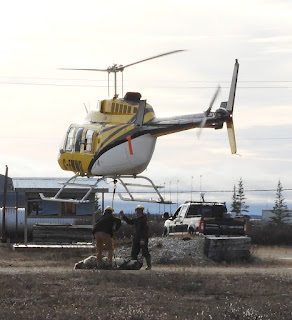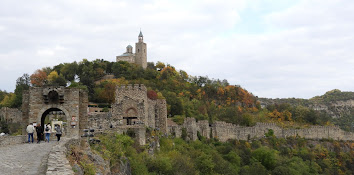 |
| Huskies ready to go |
Dave is a musher, a 3rd generation Churchillian and a member of the Metis people. His children are, obviously, 4th generation Churchillians. He has 11 grandchildren living in Churchill. The entire family is engaged in the dog sledding business.
Dave has 40 dogs, about 1/3 of which are rescue dogs, retrieved sometimes at considerable cost from people, he said, “who don’t understand dogs”. He loves his dogs, all Northern Huskies, talks to them, pets them, cooks just the right mix of protein and fat for their meals, grooms them and, most important, trains them to love to run. And his dogs do love to run. They are lean and muscular and do not look like a typical Husky except for their bright blue eyes.
 |
| Huskies in their pen |
We arrived for our dog sledding
adventure—actually, dog carting since there was no snow and we rode in 2-person
wheeled carts behind 8-dog teams—on a cold, windy morning to see 4 teams of
dogs howling and yapping and tugging in their excitement over their upcoming
run. The dogs were dismayed that we were
so slow getting into our carts. Once
aboard, the musher let the teams loose and off we went on a wild, fast,
exhilarating ride, all of us laughing at the dogs and the speed.
 |
| Huskies and handlers by cart |
Dog mushing isn’t just a smooth flow. One of the dogs made a brief stop to poop, causing a moment of chaos in the pack and requiring our musher to stop the team, leap off the back of the cart, lift the offending dog off the ground as he untangled her from her harness and promptly move on, all in less than 60 seconds. Several times, the dogs tangled themselves as one dog or another nipped a neighbor or leaped in too much enthusiasm, leading to more lifting and sorting out of dogs. Then they were off again, dogs yelping in pleasure at being able to run.
In a team of 8 dogs, harnessed in pairs, the first 2 dogs are the lead dogs, trained to be in the lead and guide the pack. The next 4 dogs are the pullers and the final 2 are the wheel dogs who do the Herculean work of keeping the sled or cart stable and pulling above their weight. Each dog has a predisposition for a particular type of pulling, so Dave works with them to find the place they like best. Then it is a labor of love and effort to mold them into a team that likes running and pulling together.
 |
| wishful Husky |
The dogs live in a large
compound, each on a long tether attached to its own dog house and far enough
from the other dogs to avoid fights. The
dog houses are not insulated, but do have fresh straw on the dirt floors. But, the dogs are usually hot and often pull
out the straw so they can sleep on the ground, even on very cold nights. Their fur has 2 layers, a short layer of fur
and a long outer layer that overlays the short layer.
These are racing dogs who love pulling
a sled and competing in long, cold races over a frozen land.





















































